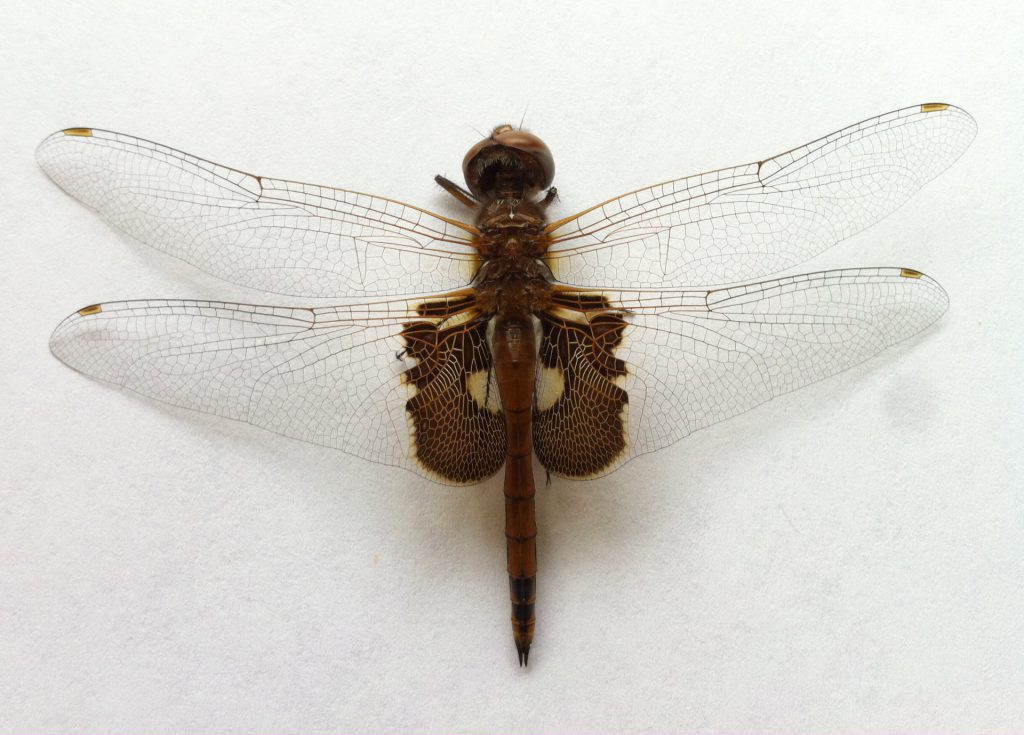It fluttered soundlessly to earth at my feet, like a tiny paper airplane, tossed by some unseen hand. Instinctively I glanced around, seeking its origin. Where did that come from?
Headed down the sidewalk in a hurry, thinking hard about assorted this and thats, I had almost missed it. Had I not happened to notice, my next footfall would have crushed it. I would have heard and felt the impact, would have paused to examine the wreckage, and would instantly, keenly have regretted the small act of accidental destruction.
But its motion had caught my eye. So the thoughts were momentarily suspended, the feet were ordered to a halt, and the little dragonfly was spared that final indignity. I stooped to examine it.
A moment before it had been fully alive, flitting about, doing what dragonflies do. But something inside it had broken, and in an instant, a thousand million interlinked living mechanisms were disrupted, and the little being fell from the sky, frozen in the moment of its fatal infarction.
The life had not entirely fled from it yet, and its wings trembled ever so slightly as I lifted it, gently, from the concrete. It had form, occupied space, displaced some measurable amount of nothingness, yet by some accident of nature had no discernible mass whatsoever. It was like holding a hologram.
There was still a flicker of awareness in its enormous compound eyes, which beheld me impassively, thirty thousand individual eyelets staring, each bearing a tiny reflection of me regarding it regarding me.
A dragonfly is study in contradictions, at once fearsome-looking yet unspeakably delicate, ancient yet incomprehensibly advanced, like some alien cyber-thing from fifty million years in the future. Should our species manage, improbably, to survive indefinitely, someday our distant descendants may wield such technology.
They are all around us, all the time, yet elusive as ghosts. They appear like magic after a rain and then vanish just as suddenly. They pop into and out of existence, seemingly, leaving no trace.
When you are a child, you think that you might somehow, someday, catch one, a tantalizing, impossible feat. If a human parses the world at twenty-four frames a second, a dragonfly slices twenty times as finely. It catches a mosquito in mid-flight, and then another, and then another, in the time it takes you to draw a single breath. A snail would have a greater chance of catching a mouse.
Once many years ago, one chanced to land on my knee as I sat in the sun, reading a book. My eyes were still young and strong then, and I was able to study the small creature for a few seconds. It simply pulsed with energy. Every appendage, every pore, every millimeter of the dragonfly’s body was in restless, nonstop motion. It was the very definition of alive. I willed myself to be immobile, hoping to prolong the moment, but inevitably, some minor twitch or quiver I was not even aware of exceeded its tolerance, and off it went.
For a moment I wondered if it had mistaken me for something static, a stump or a rock. But it knew, of course, in some rudimentary, algorithmic way that this was not so. It assessed: Threat or non-threat? and made an easy judgement call. In an odd way, I was flattered.
You can easily go a lifetime without ever having the chance to hold one in your hand. And when that rare opportunity finally comes you just might hesitate. Surely, you think, even at death’s door, a thing so seemingly ferocious can bite or somehow smite in some unforeseen way. But even were it so inclined, my captive was done with all that. As I watched, what small amount of life was still in it left, and the little creature crossed the event horizon. It quivered once, twice, and then lay entirely still.
Big thinkers, a mostly cynical bunch, are fond of saying that life is an illusion, because all supposedly living things are ultimately composed of non-living components, an irreconcilable, disqualifiying contradiction. A truly “living” being, it follows, would necessarily exist independent of physicality, and in some transcendent yet indisputable sense be animate at every conceivable frame of reference, down to the infinitely microscopic. Those aggregations of biochemical processes we call “organisms,” it further follows, are no more than simulations of life, virtually alive, but not actually.
But I believe they have it wrong. What is life but highly directed energy? Is not every single atom of which we are composed a tiny universe unto itself, surging with energy–primal, chaotic, inexhaustible, and eternal? Are we not conduits for that primal energy, and endlessly nuanced expressions of it?
And if that’s not “alive,” then what is?
© 2017 By Scott P. Snell
Right of reuse is freely granted with proper attribution.


Thank you for the sweetness of your writing heart…When a bee buzzes close to me, I figure he must think I am a flower. And in my heart, I know, I am in his world and he is just investigating his surroundings. I love those bees. Beautiful writing. Thanks to my friend Tim, sharing your link.
awesome literary gift, Scott
Thank you-I am glad I paused to read this